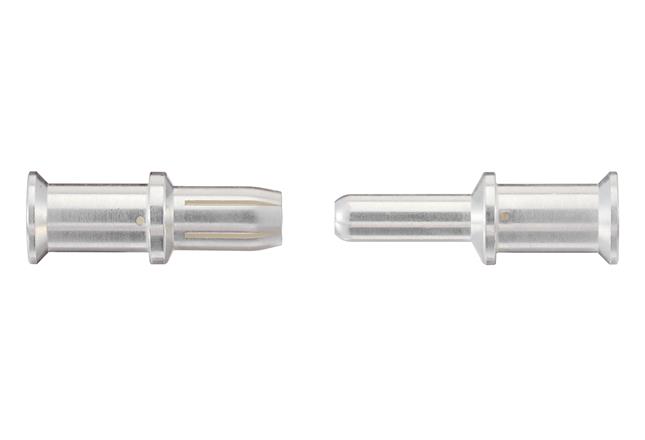| Attribute | Value |
|---|---|
| Product Category: | |
| Manufacturer: | HARTING |
| Manufacturer Part Number: | HARTING 09110006133 |
| Gender: | Male |
| Series: | TC 70 |
| Wire Size: | 25 mm² |
| Mating Cycles: | 500 cycle |
| Contact Design: | Machined |
| Current Rating: | 70 A |
| Contact Plating: | Silver |
| Contact Material: | Copper Alloy |
| Stripping Length: | 15.5 mm |
| Contact Resistance: | .5 mΩ |
| Termination Method: | Crimp |
| Maximum Operating Temperature: | 125 °C |
| Minimum Operating Temperature: | -40 °C |
| SKU: | HRT09110006133 |
09110006133
| Heilind Number: | HRT09110006133 |
| Manufacturer: | HARTING |
| Manufacturer Number: | 09110006133 |
| Datasheet: | Datasheet |
| ECAD Model: |
Description:
HARTING offers a large range of terminations technology for contacts: - Screw terminal - Crimp terminal - Axial screw terminal - Cage-clamp terminal - IDC (Insulation displacement terminal) - Han-Quick Lock® termination technique
More >>Specifications
Detailed Description
HARTING's TC 70 Crimp Contact for male connectors offers reliable termination technology for high-current applications. Featuring a robust copper alloy construction with silver plating, these contacts ensure excellent conductivity and durability. With a wire size of 25 mm² and a current rating of 70 A, they are suitable for heavy-duty use. The machined contact design guarantees precision and consistency in performance. Operating efficiently in temperatures ranging from -40 °C to 125 °C, they are ideal for diverse environmental conditions. With a low contact resistance of .5 mΩ and a mating cycle of 500, these contacts provide long-lasting and stable connections. RoHS compliant and with a stripping length of 15.5 mm, they meet international standards for quality and safety in connectivity solutions. Perfect for industrial and commercial applications, the TC 70 Crimp Contact is a reliable choice for your connectivity needs.
Frequently Bought Together
| Product | Part # | Description | Stock |
|---|---|---|---|
 | HARTING 09110006231 | Crimp contact, female, 10 MM2 |  |
 | HARTING 09110006235 | Crimp contact, female, 35 MM2 |  |
 | HARTING 09120173101 | insert, Size: Han-Compact®, female, 10 A, 250 V |  |
 | HARTING 09140023041 | Han® 70 A module, male, 2 contacts, 70 A, 1000 V |  |
 | HARTING 09140060361 | Han-Modular®, Hinged frame, for 2 modules, A ... B; Size: 6 B |  |
 | HARTING 09140083001 | Han® EE module, male, 8 contacts, 16 A, 400 V |  |
 | HARTING 09140100361 | Han-Modular®, Hinged frame, for 3 modules, A ... C; Size: 10 B |  |
 | HARTING 09140160361 | Han-Modular®, Hinged frame, for 4 modules, A ... D; Size: 16 B |  |
 | HARTING 09140173001 | Han® DDD module, male, 17 contacts |  |
 | HARTING 09140240303 | Hinged frame, zinc die-cast, Size: 24 B |  |
 | HARTING 09150006106 | Crimp contact, male, 2.5 MM2 |  |
 | HARTING 09300065425 | Protection covers for hoods cable to cable, aluminium die-cast, IP65 |  |
 | HARTING 09320006108 | Crimp contact, male, 6 MM2 |  |
 | HARTING 09320006207 | Crimp contact, female, 4 MM2 |  |
 | HARTING 09330006102 | Crimp contact, male, 2.5 MM2 |  |
 | HARTING 09400240301 | Housings, bulkhead mounting, 24 B, aluminium die-cast, corrosion resistant |  |
 | HARTING 19120080526 | Hoods, Han-Compact®, zinc die-cast, powder-coated, Style: High construction |  |
 | HARTING 19300241542 | Hoods, 24 B, aluminium die-cast, powder-coated, Style: Low construction, IP65 |  |
Product Change Notice
| Effective Date | Description of Change | Download | |||
|---|---|---|---|---|---|
| 09/02/2022 | PCN22001CN-US - product change. Implementation of a radius to the end of the inlet funnel of the crimp hole. This change optimizes handling in the crimping process. | Download | |||



